|
|
|
|
WWI British Mk.IV Male
Tamiya, 1/35 scale
Reviewed by Brett Green
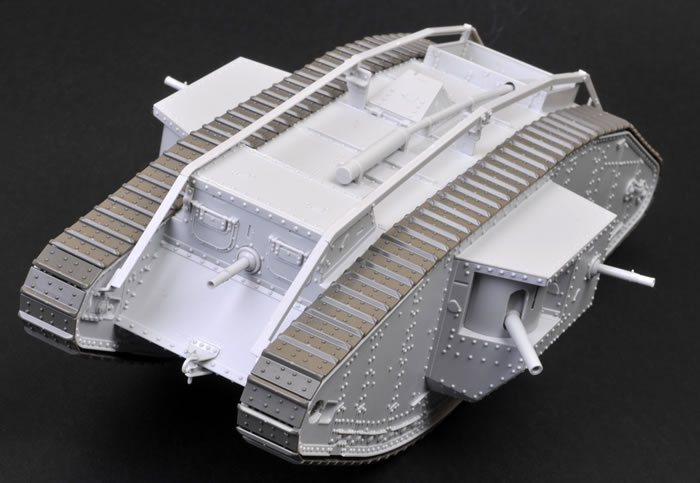
| Stock Number and Description | Tamiya Kit No. 30057 - WWI British Mk.IV Male |
| Scale: | 1/35 |
| Media and Contents: | 321 light grey plastic parts; 176 medium grey plastic individual track links; polythene caps; length of string (the final kit will also include a motor with various gears and associated equipment). |
| Price: | TBA |
| Review Type: | Test Shot Preview and Build |
| Advantages: | High level of detail; authentic surface textures; brilliant individual track links; excellent fit; optional position hatches; clever motorisation. |
| Disadvantages: | Some won’t like the motorisation. |
| Recommendation: | Tamiya has captured the rugged rhomboid lines of the Mark IV Male tank with this new 1:35 scale kit. The raised structural features such as the domed rivets are particularly well done. This will be a great starting point for your WWI collection. |
Background
The British Mark I was the world's first tank to enter combat.
Born of the need to break the domination of trenches, barbed wire and machine guns over the battlefields of the Western Front, it was the first vehicle to be named "tank", a name chosen as an expedient to maintain secrecy and to disguise its true purpose.
It was developed to be able to cross trenches, resist small-arms fire, travel over difficult terrain, carry supplies, and to capture fortified enemy positions. It is regarded as successful in many respects, but suffered from many problems owing to its primitive nature. Armament was naval 6-pounder guns and machine guns.
The Mark I entered service in August 1916, and was first used in action on 15 September 1916 during the Battle of Flers-Courcelette, part of the Somme Offensive. With the exception of the few interim Mark II and Mark III tanks, it was followed by the largely similar Mark IV
The Mark IV was introduced in 1917. It benefited from significant developments on the first British tank, the intervening designs being small batches used for training. The major improvements were in armour, the re-siting of the fuel tank, and easier transportation.
The Mark IV was first used in mid 1917 at the Battle of Messines Ridge. It remained in official British service until the end of the War, and a small number served briefly with other combatants afterwards.
A total of 1,220 were built: 420 "Males", 595 "Females" and 205 Tank Tenders (unarmed vehicles used to carry supplies), which made it the most produced British tank of the War.*
* History courtesy of Wikipedia www.wikipedia.org
In the Box
Before describing the contents, I should first let you know what I have here. This is an early test shot direct from Tamiya, and as such it does not yet have any of the motorisation gear, or decals, or some of the associated hardware such as the chain.
Also, the kit is moulded in light grey, rather than the customary tan coloured plastic that we will probably see for the official release.
Even so, these grey sprues give us a very good impression of what we can expect to find in the commercial release.
My Tamiya 1:35 scale Mark IV Male test shot comprises 321 parts in light grey plastic and another 176 individual tracks links in medium grey.
Surface detail is excellent. Just like the real Mark IV, Tamiya’s model is festooned with prominent domed rivets. These are supplemented by raised hinges, peep-hole covers, bolt heads and a myriad of other structural details. Panel lines are recessed where armour plates are butted together.
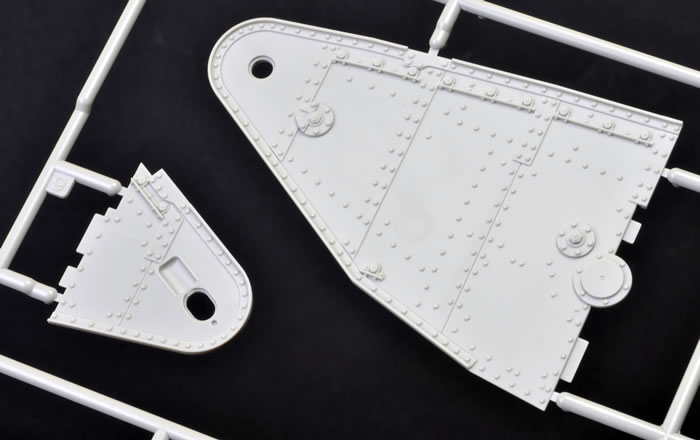
The kit has been designed to be motorised, but there are few compromises as a result. Use of polythene caps for means that various panels may be removed to provide access to batteries and the motor even after the model has been assembled and painted. The only protrusion is the on-off switch on the bottom of the hull, and on my sample even that is flashed over. As mentioned, my sample does not have any of the motorisation gear, but assembly of these elements is covered in the instructions. It all looks pretty straightforward.
The distinctive rhomboid hull is broken down into a classic “flat pack”. As a result, moulding quality is perfect with no ejector pin circles on any of the external surfaces. The driver’s visors, the sponson hatches and roof hatch are all separate and may be posed open if desired. There are a few ejector pin circles on the insides of some of these hatches.
The main body is broken down into hull top, rear, front, bottom and inner and outer side sub-assemblies. The outer hull sides are themselves split into front, mid and rear panels, with the sponsons representing a separate and removable sub-assembly.
The six-pounder naval guns are nicely detailed, including separate breechblocks and sights. They are cleverly mounted via polythene caps, which allows easy elevation and rotation after assembly.
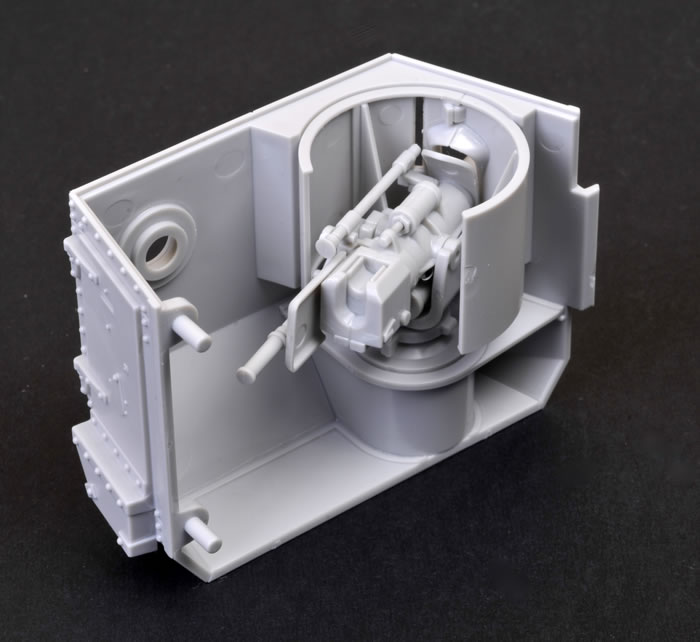
Around half the light grey parts are for the running gear – 156 are for the road wheels alone. These are mounted on axles moulded to the inner hull halves.
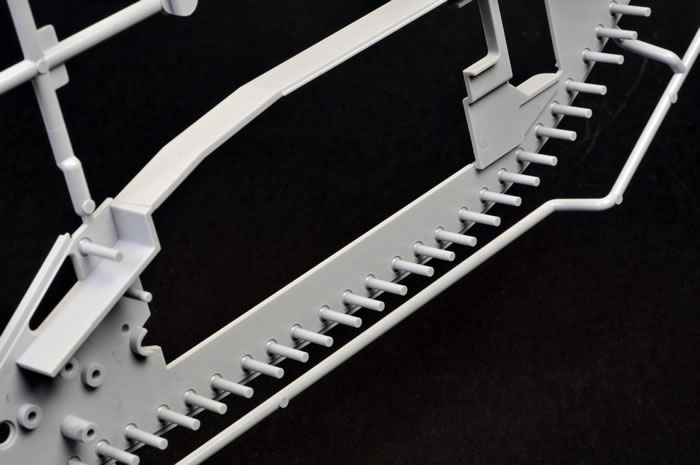
You should test fit the wheels carefully, as some pairs (and even one set of four) need to be interleaved before being pressed home onto their axles.
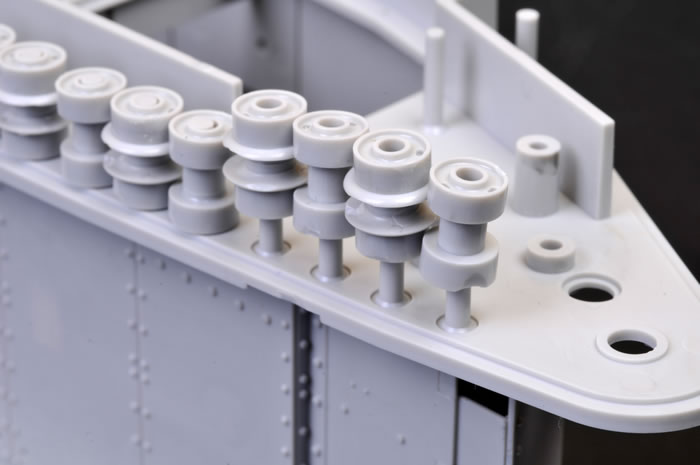
Tamiya suggests that the axles should be lubricated, but the surface area where the wheels touch the tracks is so fine that the tracks should move efficiently even if the wheels do not rotate.
The tracks are a revelation. They are ready to use straight from the box – no sprue attachments or flash on any of my sample parts. I simply tipped them from their bags and started clipping them together. The links click together positively and quickly. Simply slip one pin into one hole on the next link, stretch and click the second pin into place.

I did not have a single problem in assembling each run of 87 links. The plastic is flexible enough to stretch while the pins are being fitted, and solid enough to hold the links together. The whole length is really quite robust.
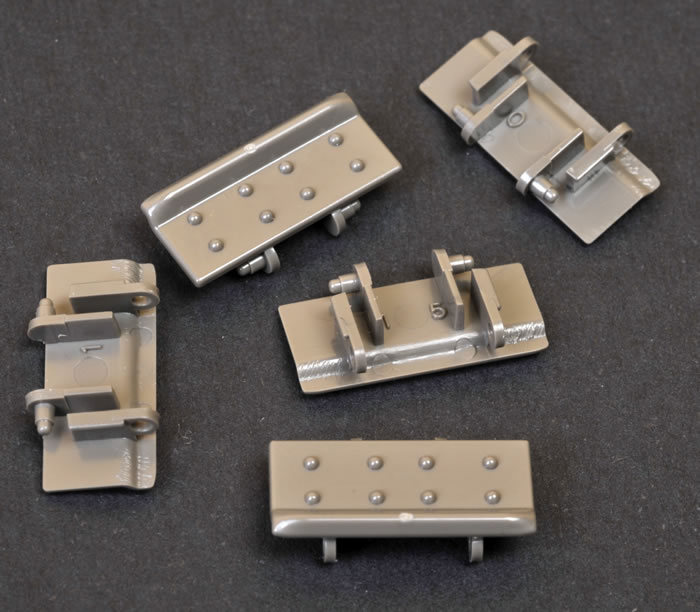
The outer detail of the track links is crisp, and the side detail is convincing too. There is a single ejector pin mark on the inside surface of each link, but these are completely hidden once the tracks are fitted. These might just be the nicest track links that I have ever had the pleasure to work on.
Construction
I built my model over the course of three days. As you would expect from a Tamiya kit, fit was close to perfect in all areas.
The model was built according to the instructions, with the motorisation steps skipped.
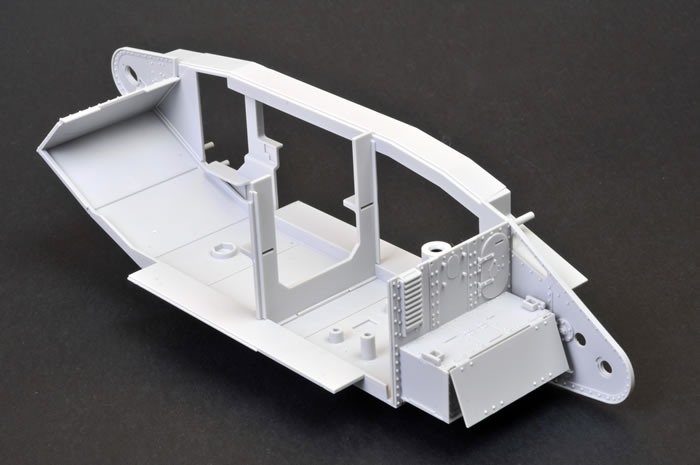
The single most time-consuming task was assembling the 54 small road wheels. 30 of these are made up from two parts each; and another 24 from four parts each. Clean-up was a bit tedious, but I found that even that chore could be kept to a minimum if the inner road wheel sections – Parts A3 and A4 – were sliced off the sprue at an undercut angle (hopefully this will make sense when you see how the parts are attached to the sprue).
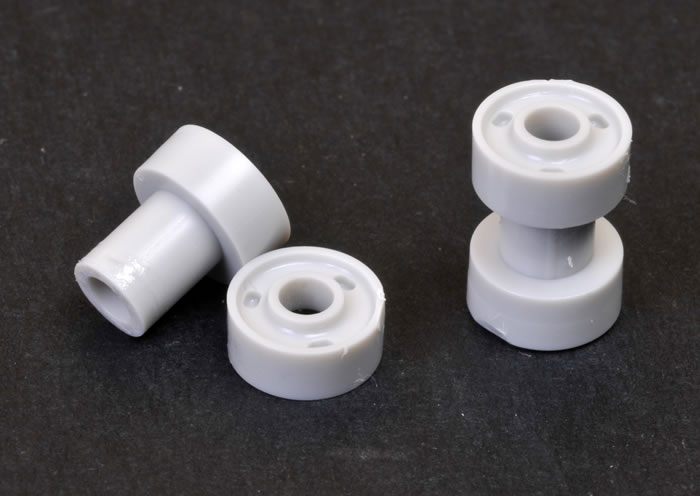
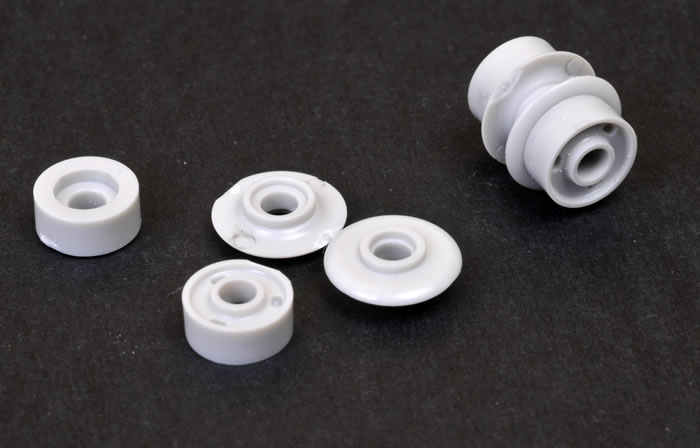
In the end, removing all the running gear parts, cleaning them up and assembling them only took around two hours.
I had to deviate from the instructions when assembling the drive sprocket and idler wheels as the production kit parts will feature metal sprockets and nylon gears, and these were not included with my early sample. Examining the sprues, however, I noticed a set of two plastic drive sprockets and two idler wheels, plus four short lengths of tube that were not mentioned in the instructions. The drive sprockets were assembled and fixed to the rear of the vehicle. Parts A20, A21 and A22 held the sprockets in place and still allowed them to rotate.
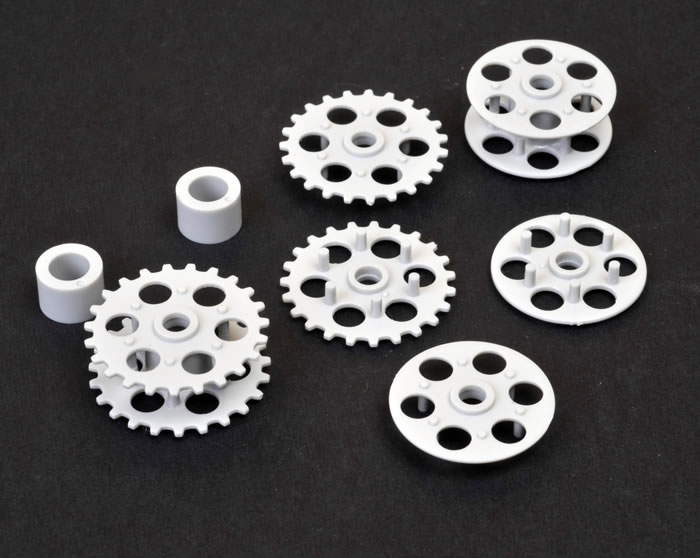
I had to fabricate axles for the idler wheels, as these parts did not appear to be on the sprues. I simply cut two short lengths of brass tube and glued them inside the spacer tubes. Remember, you won't have to do this as your kit will have the metal motorisation parts.
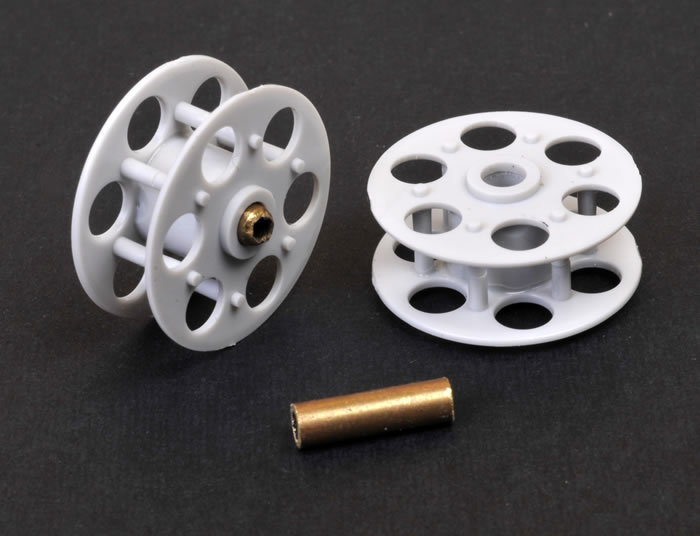
The idler wheels were then clipped between the inner and outer hull halves. The kit features a working track tensioner on the idler wheels, so I took care to leave the brass axle loose in its capsule-shaped mount. This will make it easier to attach the tracks and adjust the tension at the very last assembly step.
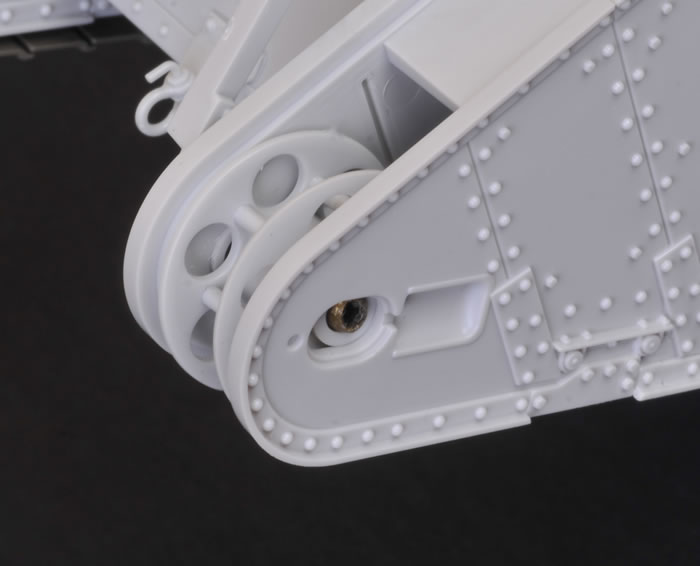
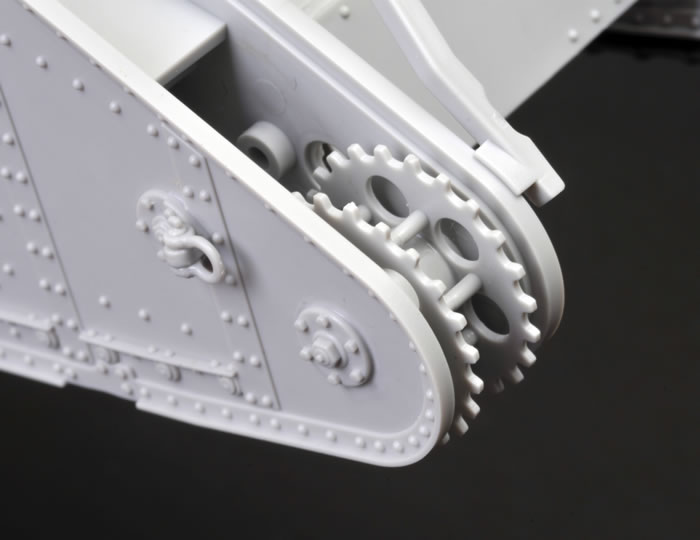
Assembling the track links was next. This was a fast and satisfying job. Pick up link, click together, pick up next link, click together; and repeat until you have 87 links per side.
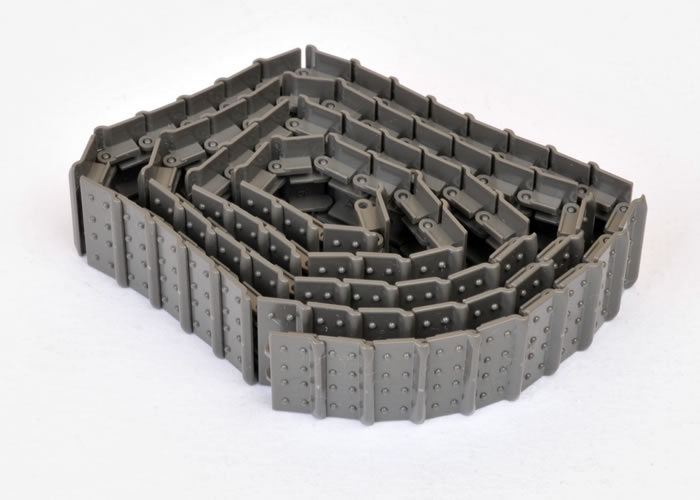
I test-fitted my tracks to the unpainted hull as I thought it might be tricky to make that final click-join to link each end of the tracks.
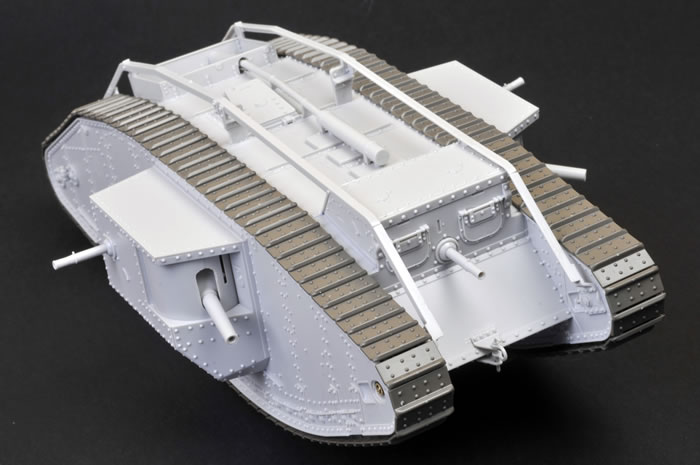
However, I found that there was a certain amount of “stretch” to the completed track length, allowing the final link to be clicked in place with a minimum of fuss.
Conclusion
Tamiya has captured the rugged rhomboid lines of the Mark IV Male tank with this new 1:35 scale kit. The raised structural features such as the domed rivets are particularly well done.
The motorisation of this model was a surprise to many, but a milestone reached this year might explain it. 2014 marks Tamiya’s 40th anniversary of radio control models. The very first Tamiya R/C model was an M4 Sherman, so perhaps their new motorised Mark IV is an acknowledgement of this landmark.
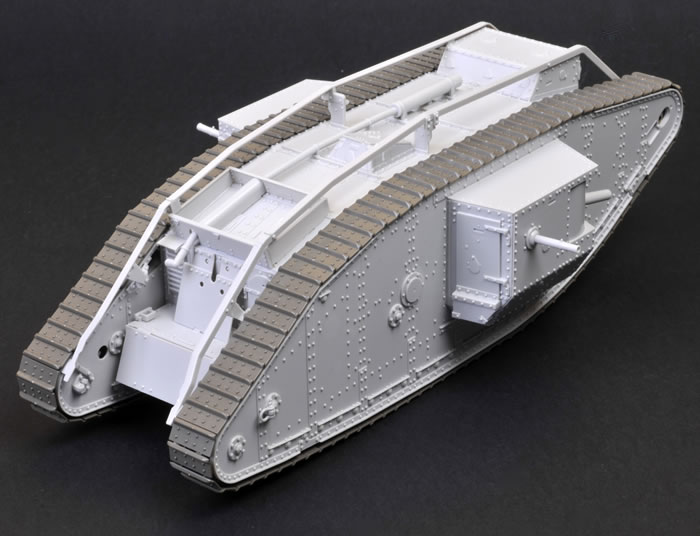
2014 is also the 100th anniversary of the outbreak of the First World War, so it is not surprising that Tamiya has chosen this year to debut its Great War range. I am sure that we will see a plenty of long-overdue attention over the next few years on the vehicles, equipment and troops of WWI.
Tamiya’s 1:35 scale British Mark IV Male tank will be a great starting point for your WWI collection!
Thanks to Tamiya Japan for the sample www.tamiya.com
Tamiya kits are distributed in the UK by The Hobby Company Limited www.hobbyco.net
Text and Images by Brett Green
Page Created 8 June, 2014
Page Last Updated
9 June, 2014

























































